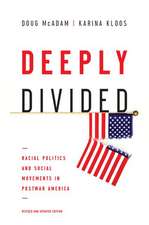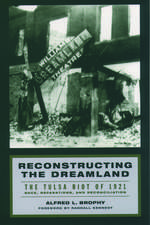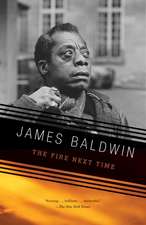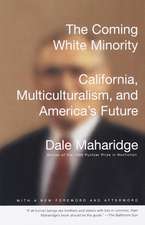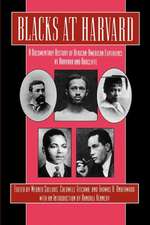Interracial Intimacies: Sex, Marriage, Identity, and Adoption
Autor Randall Kennedyen Limba Engleză Paperback – 31 dec 2003
Analyzing the tremendous changes in the history of America’s racial dynamics, Kennedy takes us from the injustices of the slave era up to present-day battles over race matching adoption policies, which seek to pair children with adults of the same race. He tackles such subjects as the presence of sex in racial politics, the historic role of legal institutions in policing racial boundaries, and the real and imagined pleasures that have attended interracial intimacy. A bracing, much-needed look at the way we have lived in the past, Interracial Intimacies is also a hopeful book, offering a potent vision of our future as a multiracial democracy.
Preț: 178.69 lei
Nou
Puncte Express: 268
Preț estimativ în valută:
34.20€ • 35.57$ • 28.62£
34.20€ • 35.57$ • 28.62£
Carte disponibilă
Livrare economică 21 februarie-07 martie
Preluare comenzi: 021 569.72.76
Specificații
ISBN-13: 9780375702648
ISBN-10: 0375702644
Pagini: 688
Dimensiuni: 133 x 205 x 40 mm
Greutate: 0.7 kg
Ediția:Vintage Books
Editura: Vintage Publishing
ISBN-10: 0375702644
Pagini: 688
Dimensiuni: 133 x 205 x 40 mm
Greutate: 0.7 kg
Ediția:Vintage Books
Editura: Vintage Publishing
Notă biografică
Randall Kennedy is the author of Nigger and Race, Crime, and the Law. He received his undergraduate degree from Princeton and his law degree from Yale. A Rhodes Scholar, he served as a law clerk to Supreme Court Justice Thurgood Marshall. He is a professor at Harvard Law School and lives in Dedham, Massachusetts.
Extras
Chapter One
In the Age of Slavery
White Men/Black Women
Slavery constituted the principal backdrop against which whites and black encountered one another for over two hundred years, from the 1660s to the 1860s. The overwhelming majority of slave owners were white, and the overwhelming majority of slaves black.* There was probably more black-white sex during this period than at any other time (thus far) in American history. Most of it was unwanted sex, stemming from white males' exploitation of black women-the subject of many pages to come.? But what about mutually desired sex or what I refer to as sexual intimacy? Some commentators insist that there can have been no such thing as sexual intimacy between a black enslaved woman and any white man-a slave owner or overseer or even a mere stranger-because mutually desired sex requires choice, a power denied to slaves by bondage. According to this view, slavery created an extreme dependency that precluded the possibility of chosen as opposed to unwanted sex. As a result, all of the sex that took place between enslaved women and white men constituted some form of sexual assault. Professor Angela Davis is among those who make this argument. Criticizing the notion that a slave woman could consent to have sex with a master, Davis maintains that "there could hardly be a basis for 'delight, affection and love' as long as white men[,] by virtue of their economic position, had unlimited access to Black women's bodies." Proponents of this view are right to stress the cruel coerciveness of slavery.* While the specifics of bondage varied widely over time and from place to place, the condition itself always endowed masters with despotic personal power over their human property.
A vivid illustration of slavery's despotism is State v. Mann, an 1829 decision in which the North Carolina Supreme Court reversed the conviction of a white man who had been prosecuted for criminally assaulting a female slave. John Mann had shot a leased slave named Lydia when, for reasons that are unclear, she ran away from him and refused to stop. Writing for the court, Judge Thomas Ruffin declared that under common law, the intentional wounding of a slave by a master did not rise to the level of a crime. In explaining the court's conclusion, Ruffin described the terrible core of American racial slavery with eloquent, if chilling, clarity. The slave, he observed, was "one doomed in his own person, and his posterity, to live without . . . the capacity to make anything his own, and to toil that another may reap the fruits." Absent legislation, masters should be permitted to discipline slaves in whatever way they saw fit, because, Ruffin asserted, "we cannot allow the right of the master to be brought into discussion in the Courts of Justice. The slave, to remain a slave, must be made sensible, that there is no appeal from his master; that his power is in no instance, usurped; but is conferred by the laws of man at least, if not by the law of God." It was good policy, Judge Ruffin insisted, for courts to refrain from criminalizing even cruel and unreasonable battery on slaves by their owners, for the only thing that could create the obedience that slavery required was "uncontrolled authority over the body." "The power of the master," he postulated, "must be absolute, to render the submission of the slave perfect."
The slave system failed, however, to perfect the domination that Ruffin envisioned. It failed to bind the slaves so tightly as to deprive them of all room to maneuver. It failed to wring from them all prohibited yearnings. Slavery was, to be sure, a horribly oppressive system that severely restricted the ambit within which its victims could make decisions. But slavery did not extinguish altogether the possibility of choice. It was that possibility which endowed slaves with moral responsibility then, and which renders them susceptible to moral assessment today. It is precisely because they made wrong choices, albeit in excruciating circumstances, that slave informants who betrayed other slaves can appropriately be condemned. Similarly, it is because enslaved rebels made right choices in difficult situations that they can now be applauded. In the next chapter, in a discussion focusing on the sexual exploitation of enslaved African American women, we shall meet Harriet Jacobs, a slave who experienced tremendous suffering at the hands of a wickedly lecherous master.* Jacobs left a wonderful memoir that tells us how, even in the midst of her terrible predicament, she was able to make important decisions. She decided, for example, to resist her master's advances, and she chose to have sex with a different white man, whose children she bore, because for her "it seem[ed] less degrading to give one's self than to submit to compulsion." As a keen observer wrote over a century later, "One might be tempted to characterize [Jacobs] as a victim of her circumstances. But she repeatedly demonstrated her ability to transform the conditions of her oppression into the preconditions of her liberation and that of her loved ones."
Harriet Jacobs was not alone in exercising self-expression and self-assertion from within a position of enslavement. Bondage severely limited the power-including the sexual power-of slaves. But it did not wholly erase their capacity to attract and shape affectionate, erotic attachments of all sorts, including interracial ones. In a hard-to-quantify but substantial number of cases, feelings of affection and attachment between white male masters and their black female slaves somehow survived slavery's deadening influence.* The great difficulty, in any particular instance, lies in determining whether sex between a male master and a female slave was an expression of sexual autonomy or an act of unwanted sex. The truth is that most often we cannot know for sure, since there exists little direct testimony from those involved, especially the enslaved women. There is good reason to presume that most of the sex between masters and slaves was unwanted by the latter, who were forced into accepting it by subtle threats or brute violence. Coerced sex was a widespread, feared, and traumatic aspect of enslavement. This is hardly surprising, for it would be difficult to construct a context more conducive to sexual exploitation than American racial slavery. Masters owned slaves and largely dictated the conditions under which they toiled. They could assign troublesome individuals backbreaking tasks or reward favorites with less burdensome duties. They could break up enslaved families or keep them together. They could condemn the living children or future progeny of slaves to bondage or hold out the possibility of emancipating them in return for satisfying service. We may get some sense of the imbalance of power by considering that today, even though sexual harassment has been outlawed in many settings, some bosses continue to impose unwanted sexual attention on their subordinates. Slave masters constituted the ultimate bosses. But perhaps no analogy to a contractual employment relationship can sufficiently convey the inherent coerciveness of slavery; a better analogue may be the prison guard who lords it over incarcerated women. After all, in addition to facing brutal sexual assaults, women inmates commonly face subtler forms of compulsion, often in the guise of coercive offers. Yet slaves were even more vulnerable than inmates to sexual exploitation. A master's control over the fate of a slave woman's children and other kinfolk was a much more powerful tool than anything at the disposal of a prison guard. Furthermore, slaves were prohibited from testifying against masters, and almost all American jurisdictions failed even to recognize as a crime the rape of a slave.
We can be sensitive to the plight of enslaved women, however, and still acknowledge that consensual sex, prompted by erotic attraction and other mysteries of the human condition, has occurred between subordinates and superiors in even the most barren and brutal settings. Evidence of consensual sexual intimacy within the confines of bondage is found in the unusual solicitude shown by certain masters toward slaves with whom they had sex and by whom they sired children. Freeing a slave mistress or the offspring of such a union, acknowledging paternity of or assuming financial responsibility for a slave's children, marrying a former slave-all of these are potentially telltale signs of affection.
Drawing inferences from such conduct is a hazardous undertaking. Some slaveholders did not view manumission as a sign of affection; on the contrary, perceiving bondage to be a positive good for slaves as well as masters, they deemed emancipation an act of cruelty. One such master was James Henry Hammond, a governor of South Carolina who owned nearly 150 slaves. At least two of their number, a mother and a daughter, were mistresses by whom he probably sired children. In a letter requesting that his son by his legal (white) wife care for these women and their offspring in the event of his death, Hammond declared, "I cannot free these people & send them North. It would be cruelty to them. Nor would I like that any but my own blood should own as slaves my own blood. . . . Do not let . . . any of my children or possible children be the Slaves of Strangers. Slavery in the family will be their happiest earthly condition."*
Nor was every master's conduct toward the child he sired necessarily indicative of the conditions under which that child had been conceived. David Dickson was a rich white Georgian who attentively raised, educated, and supported Amanda America Dickson, the daughter he fathered by one of his many slaves. It would be a mistake, however, to read into his relationship with Amanda's mother the tender solicitude that Dickson showered upon his daughter. According to a careful scholarly study, as well as the oral tradition of the black side of the Dickson family, Amanda was conceived by rape one day in 1849, when her forty-year-old father decided to initiate sexually a thirteen-year-old slave girl to whom he took a sudden fancy as she worked in his fields.
More generally, though, and given the indifference, hostility, and denial typically displayed by white men who had sex with slaves, acknowledgments of a sexual partner or of the offspring of a sexual liaison may be regarded as unusual acts that probably betokened some variety of tender attachment. The more evident such acts of acknowledgment were in any specific case, the more confident we can be in describing the relationship as "intimate." That adjective may surely be applied, for example, to the relationship between Thomas Bell, a white businessman, and Mary Hemings, one of Thomas Jefferson's many slaves. In the 1780s, Jefferson leased Hemings to Bell, who fathered two children by her. Several years into the leasing arrangement, Hemings asked Jefferson to sell her and her two children to Bell; after Jefferson did so, Hemings, Bell, and their children openly lived together, and Hemings adopted Bell's last name.
Another intimate relationship united Thomas Wright, a prosperous landowner in Prince Edward County, Virginia, and Sylvia, one of his slaves. The two began living together in the late 1770s, and though they never married (such a marriage would have violated Virginia law), Wright never hid the nature of their companionate relationship from others. They lived, neighbors recalled, "as man and wife." Wright freed his mistress's two children by a fellow slave (born before Wright purchased her) as well as the four children they had together, whom he also assisted financially.
In yet another case, Ralph Quarles, a prosperous Virginia plantation owner and military hero of the Revolutionary War, entered into an intimate association with Lucy Langston, a black woman who had become his slave in settlement of a debt. Langston bore four children by Quarles, all of whom he emancipated along with their mother, and all of whom he carefully provided for financially. In 1834, after Quarles and Langston both died following brief illnesses, they were buried side by side, pursuant to instructions left in his will.*
The court reports of the slave states furnish scores of similar examples of white men who sought to help their black mistresses and children escape the deprivations imposed upon them by enslavement and racism. More than any other state, Louisiana provides an abundant array of such cases. Douglass Wilkins, for instance, left a will in which he emancipated his slave mistress, Leonora, and acknowledged their two sons. He also willed a $150 annuity to Leonora, bequeathed the sum of $5,000 to the sons, and stipulated that "as soon as [the boys] shall be old enough to be separated from their mother, my executors shall send them to some State of the Union in which slavery is not tolerated, to be instructed in reading, writing and arithmetic, and in some mechanical art or trade." It appears that his wishes were carried out. Like Wilkins, Elisha Crocker left the bulk of his estate to his mistress and former slave-Sofa-and the children she had borne him, whom he formally acknowledged. Crocker's white brothers and sisters challenged his will on the ground that under state law, he had had no right to bequeath to his concubine and illegitimate children any more than one quarter of his property. His siblings, of course, wanted the remainder for themselves. They prevailed insofar as the Supreme Court of Louisiana agreed with their reading of the relevant law and transferred to them three quarters of their brother's estate. Nevertheless, Crocker's mistress and three children received what he had most wished for them to have: their freedom and at least some share of the inheritance that would grant them a large measure of independence. In a third case, Jean-Baptiste Lagarde, an overseer, purchased a slave woman named Adelaide and her daughter Amelia from his employer and treated them as free. In short order Adelaide gave birth to a second daughter, Cydalize, and then contracted cholera and died. Lagarde was almost certainly the father of both Amelia and Cydalize. After their mother's death, he paid a free woman of color, Marie Louise Audat, to raise the girls as her own, a beneficent act that surely hinted at paternal solicitude. Lagarde did not, however, emancipate his daughters. No one knows why he failed to do so, though Professor Judith Kelleher Schaefer has speculated that it may have had something to do with his marrying a white woman after Adelaide died-a woman who perhaps harbored ill will toward her husband's children. Whatever his reasons, Lagarde's omission would have serious consequences, as the slave status of Amelia and Cydalize survived their father's death. Although he had apparently intended to send his daughters to live with his sister in France, he died before he could effectuate this wish. Labeled as slaves, the two girls were included in his estate and auctioned off at a probate sale. Luckily for them, Audat purchased the girls and subsequently ensured that they were formally emancipated.
In the Age of Slavery
White Men/Black Women
Slavery constituted the principal backdrop against which whites and black encountered one another for over two hundred years, from the 1660s to the 1860s. The overwhelming majority of slave owners were white, and the overwhelming majority of slaves black.* There was probably more black-white sex during this period than at any other time (thus far) in American history. Most of it was unwanted sex, stemming from white males' exploitation of black women-the subject of many pages to come.? But what about mutually desired sex or what I refer to as sexual intimacy? Some commentators insist that there can have been no such thing as sexual intimacy between a black enslaved woman and any white man-a slave owner or overseer or even a mere stranger-because mutually desired sex requires choice, a power denied to slaves by bondage. According to this view, slavery created an extreme dependency that precluded the possibility of chosen as opposed to unwanted sex. As a result, all of the sex that took place between enslaved women and white men constituted some form of sexual assault. Professor Angela Davis is among those who make this argument. Criticizing the notion that a slave woman could consent to have sex with a master, Davis maintains that "there could hardly be a basis for 'delight, affection and love' as long as white men[,] by virtue of their economic position, had unlimited access to Black women's bodies." Proponents of this view are right to stress the cruel coerciveness of slavery.* While the specifics of bondage varied widely over time and from place to place, the condition itself always endowed masters with despotic personal power over their human property.
A vivid illustration of slavery's despotism is State v. Mann, an 1829 decision in which the North Carolina Supreme Court reversed the conviction of a white man who had been prosecuted for criminally assaulting a female slave. John Mann had shot a leased slave named Lydia when, for reasons that are unclear, she ran away from him and refused to stop. Writing for the court, Judge Thomas Ruffin declared that under common law, the intentional wounding of a slave by a master did not rise to the level of a crime. In explaining the court's conclusion, Ruffin described the terrible core of American racial slavery with eloquent, if chilling, clarity. The slave, he observed, was "one doomed in his own person, and his posterity, to live without . . . the capacity to make anything his own, and to toil that another may reap the fruits." Absent legislation, masters should be permitted to discipline slaves in whatever way they saw fit, because, Ruffin asserted, "we cannot allow the right of the master to be brought into discussion in the Courts of Justice. The slave, to remain a slave, must be made sensible, that there is no appeal from his master; that his power is in no instance, usurped; but is conferred by the laws of man at least, if not by the law of God." It was good policy, Judge Ruffin insisted, for courts to refrain from criminalizing even cruel and unreasonable battery on slaves by their owners, for the only thing that could create the obedience that slavery required was "uncontrolled authority over the body." "The power of the master," he postulated, "must be absolute, to render the submission of the slave perfect."
The slave system failed, however, to perfect the domination that Ruffin envisioned. It failed to bind the slaves so tightly as to deprive them of all room to maneuver. It failed to wring from them all prohibited yearnings. Slavery was, to be sure, a horribly oppressive system that severely restricted the ambit within which its victims could make decisions. But slavery did not extinguish altogether the possibility of choice. It was that possibility which endowed slaves with moral responsibility then, and which renders them susceptible to moral assessment today. It is precisely because they made wrong choices, albeit in excruciating circumstances, that slave informants who betrayed other slaves can appropriately be condemned. Similarly, it is because enslaved rebels made right choices in difficult situations that they can now be applauded. In the next chapter, in a discussion focusing on the sexual exploitation of enslaved African American women, we shall meet Harriet Jacobs, a slave who experienced tremendous suffering at the hands of a wickedly lecherous master.* Jacobs left a wonderful memoir that tells us how, even in the midst of her terrible predicament, she was able to make important decisions. She decided, for example, to resist her master's advances, and she chose to have sex with a different white man, whose children she bore, because for her "it seem[ed] less degrading to give one's self than to submit to compulsion." As a keen observer wrote over a century later, "One might be tempted to characterize [Jacobs] as a victim of her circumstances. But she repeatedly demonstrated her ability to transform the conditions of her oppression into the preconditions of her liberation and that of her loved ones."
Harriet Jacobs was not alone in exercising self-expression and self-assertion from within a position of enslavement. Bondage severely limited the power-including the sexual power-of slaves. But it did not wholly erase their capacity to attract and shape affectionate, erotic attachments of all sorts, including interracial ones. In a hard-to-quantify but substantial number of cases, feelings of affection and attachment between white male masters and their black female slaves somehow survived slavery's deadening influence.* The great difficulty, in any particular instance, lies in determining whether sex between a male master and a female slave was an expression of sexual autonomy or an act of unwanted sex. The truth is that most often we cannot know for sure, since there exists little direct testimony from those involved, especially the enslaved women. There is good reason to presume that most of the sex between masters and slaves was unwanted by the latter, who were forced into accepting it by subtle threats or brute violence. Coerced sex was a widespread, feared, and traumatic aspect of enslavement. This is hardly surprising, for it would be difficult to construct a context more conducive to sexual exploitation than American racial slavery. Masters owned slaves and largely dictated the conditions under which they toiled. They could assign troublesome individuals backbreaking tasks or reward favorites with less burdensome duties. They could break up enslaved families or keep them together. They could condemn the living children or future progeny of slaves to bondage or hold out the possibility of emancipating them in return for satisfying service. We may get some sense of the imbalance of power by considering that today, even though sexual harassment has been outlawed in many settings, some bosses continue to impose unwanted sexual attention on their subordinates. Slave masters constituted the ultimate bosses. But perhaps no analogy to a contractual employment relationship can sufficiently convey the inherent coerciveness of slavery; a better analogue may be the prison guard who lords it over incarcerated women. After all, in addition to facing brutal sexual assaults, women inmates commonly face subtler forms of compulsion, often in the guise of coercive offers. Yet slaves were even more vulnerable than inmates to sexual exploitation. A master's control over the fate of a slave woman's children and other kinfolk was a much more powerful tool than anything at the disposal of a prison guard. Furthermore, slaves were prohibited from testifying against masters, and almost all American jurisdictions failed even to recognize as a crime the rape of a slave.
We can be sensitive to the plight of enslaved women, however, and still acknowledge that consensual sex, prompted by erotic attraction and other mysteries of the human condition, has occurred between subordinates and superiors in even the most barren and brutal settings. Evidence of consensual sexual intimacy within the confines of bondage is found in the unusual solicitude shown by certain masters toward slaves with whom they had sex and by whom they sired children. Freeing a slave mistress or the offspring of such a union, acknowledging paternity of or assuming financial responsibility for a slave's children, marrying a former slave-all of these are potentially telltale signs of affection.
Drawing inferences from such conduct is a hazardous undertaking. Some slaveholders did not view manumission as a sign of affection; on the contrary, perceiving bondage to be a positive good for slaves as well as masters, they deemed emancipation an act of cruelty. One such master was James Henry Hammond, a governor of South Carolina who owned nearly 150 slaves. At least two of their number, a mother and a daughter, were mistresses by whom he probably sired children. In a letter requesting that his son by his legal (white) wife care for these women and their offspring in the event of his death, Hammond declared, "I cannot free these people & send them North. It would be cruelty to them. Nor would I like that any but my own blood should own as slaves my own blood. . . . Do not let . . . any of my children or possible children be the Slaves of Strangers. Slavery in the family will be their happiest earthly condition."*
Nor was every master's conduct toward the child he sired necessarily indicative of the conditions under which that child had been conceived. David Dickson was a rich white Georgian who attentively raised, educated, and supported Amanda America Dickson, the daughter he fathered by one of his many slaves. It would be a mistake, however, to read into his relationship with Amanda's mother the tender solicitude that Dickson showered upon his daughter. According to a careful scholarly study, as well as the oral tradition of the black side of the Dickson family, Amanda was conceived by rape one day in 1849, when her forty-year-old father decided to initiate sexually a thirteen-year-old slave girl to whom he took a sudden fancy as she worked in his fields.
More generally, though, and given the indifference, hostility, and denial typically displayed by white men who had sex with slaves, acknowledgments of a sexual partner or of the offspring of a sexual liaison may be regarded as unusual acts that probably betokened some variety of tender attachment. The more evident such acts of acknowledgment were in any specific case, the more confident we can be in describing the relationship as "intimate." That adjective may surely be applied, for example, to the relationship between Thomas Bell, a white businessman, and Mary Hemings, one of Thomas Jefferson's many slaves. In the 1780s, Jefferson leased Hemings to Bell, who fathered two children by her. Several years into the leasing arrangement, Hemings asked Jefferson to sell her and her two children to Bell; after Jefferson did so, Hemings, Bell, and their children openly lived together, and Hemings adopted Bell's last name.
Another intimate relationship united Thomas Wright, a prosperous landowner in Prince Edward County, Virginia, and Sylvia, one of his slaves. The two began living together in the late 1770s, and though they never married (such a marriage would have violated Virginia law), Wright never hid the nature of their companionate relationship from others. They lived, neighbors recalled, "as man and wife." Wright freed his mistress's two children by a fellow slave (born before Wright purchased her) as well as the four children they had together, whom he also assisted financially.
In yet another case, Ralph Quarles, a prosperous Virginia plantation owner and military hero of the Revolutionary War, entered into an intimate association with Lucy Langston, a black woman who had become his slave in settlement of a debt. Langston bore four children by Quarles, all of whom he emancipated along with their mother, and all of whom he carefully provided for financially. In 1834, after Quarles and Langston both died following brief illnesses, they were buried side by side, pursuant to instructions left in his will.*
The court reports of the slave states furnish scores of similar examples of white men who sought to help their black mistresses and children escape the deprivations imposed upon them by enslavement and racism. More than any other state, Louisiana provides an abundant array of such cases. Douglass Wilkins, for instance, left a will in which he emancipated his slave mistress, Leonora, and acknowledged their two sons. He also willed a $150 annuity to Leonora, bequeathed the sum of $5,000 to the sons, and stipulated that "as soon as [the boys] shall be old enough to be separated from their mother, my executors shall send them to some State of the Union in which slavery is not tolerated, to be instructed in reading, writing and arithmetic, and in some mechanical art or trade." It appears that his wishes were carried out. Like Wilkins, Elisha Crocker left the bulk of his estate to his mistress and former slave-Sofa-and the children she had borne him, whom he formally acknowledged. Crocker's white brothers and sisters challenged his will on the ground that under state law, he had had no right to bequeath to his concubine and illegitimate children any more than one quarter of his property. His siblings, of course, wanted the remainder for themselves. They prevailed insofar as the Supreme Court of Louisiana agreed with their reading of the relevant law and transferred to them three quarters of their brother's estate. Nevertheless, Crocker's mistress and three children received what he had most wished for them to have: their freedom and at least some share of the inheritance that would grant them a large measure of independence. In a third case, Jean-Baptiste Lagarde, an overseer, purchased a slave woman named Adelaide and her daughter Amelia from his employer and treated them as free. In short order Adelaide gave birth to a second daughter, Cydalize, and then contracted cholera and died. Lagarde was almost certainly the father of both Amelia and Cydalize. After their mother's death, he paid a free woman of color, Marie Louise Audat, to raise the girls as her own, a beneficent act that surely hinted at paternal solicitude. Lagarde did not, however, emancipate his daughters. No one knows why he failed to do so, though Professor Judith Kelleher Schaefer has speculated that it may have had something to do with his marrying a white woman after Adelaide died-a woman who perhaps harbored ill will toward her husband's children. Whatever his reasons, Lagarde's omission would have serious consequences, as the slave status of Amelia and Cydalize survived their father's death. Although he had apparently intended to send his daughters to live with his sister in France, he died before he could effectuate this wish. Labeled as slaves, the two girls were included in his estate and auctioned off at a probate sale. Luckily for them, Audat purchased the girls and subsequently ensured that they were formally emancipated.
Recenzii
“The best book written on the subject, an exhaustive source of deep, rich scholarship and surefooted brilliant analysis.” —Seattle Times
“We urgently need Kennedy, his courage and his convictions. . . . For some time [he] has been a member of that small coterie of our most lucid big thinkers about race.” —Washington Post
“[A] vibrant, wieghty examination. . . . Kennedy writes eloquently about the violence, sadness, and warped legacy of the past, but then goes looking for intimacy anyway—instances in which some mutual feeling may have arisen across the racial divide.” —Los Angles Times
“As definitive as it is defiant. . . . One of the most important books on race in recent memory.” –Columbus Dispatch
“We urgently need Kennedy, his courage and his convictions. . . . For some time [he] has been a member of that small coterie of our most lucid big thinkers about race.” —Washington Post
“[A] vibrant, wieghty examination. . . . Kennedy writes eloquently about the violence, sadness, and warped legacy of the past, but then goes looking for intimacy anyway—instances in which some mutual feeling may have arisen across the racial divide.” —Los Angles Times
“As definitive as it is defiant. . . . One of the most important books on race in recent memory.” –Columbus Dispatch


